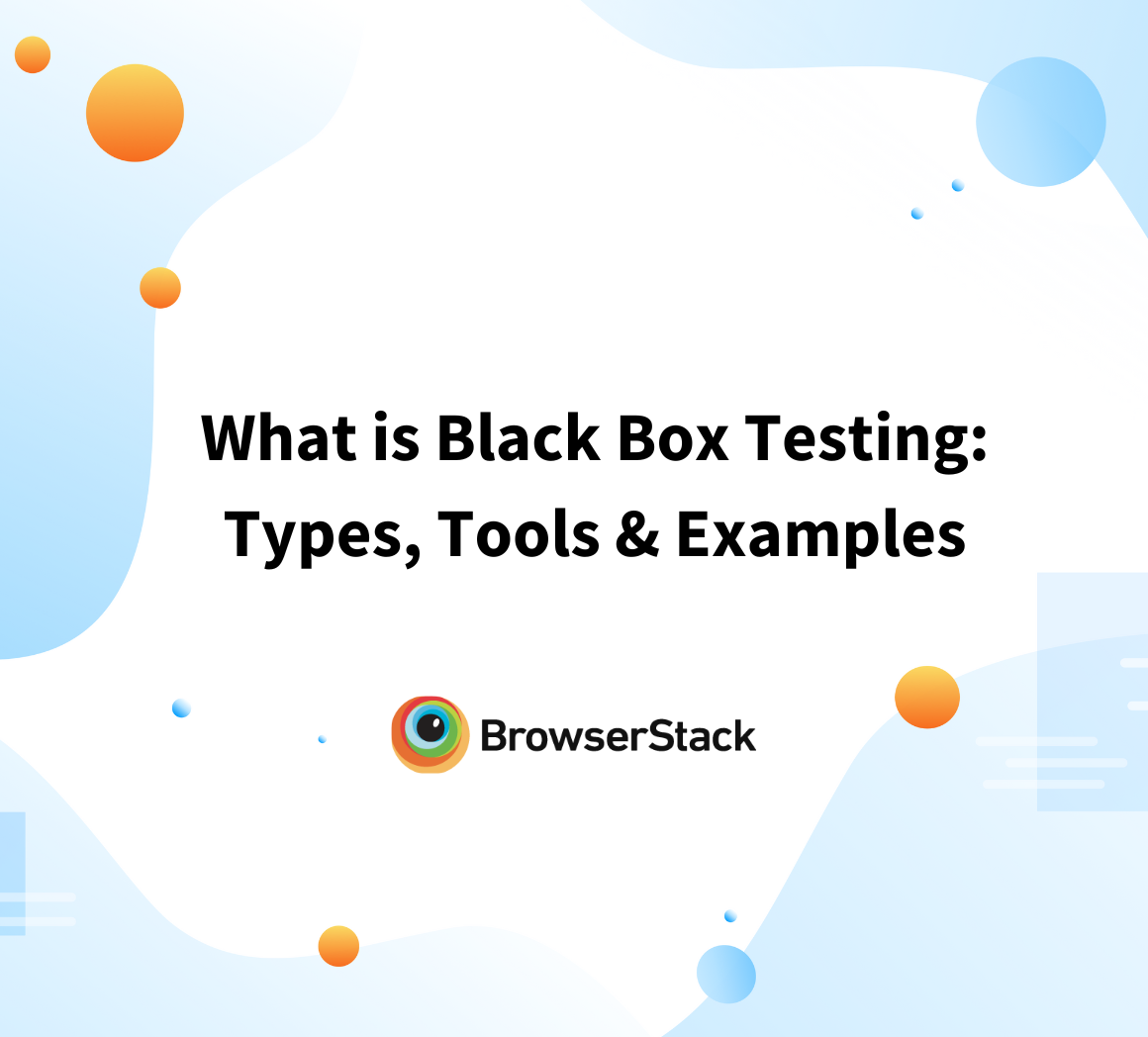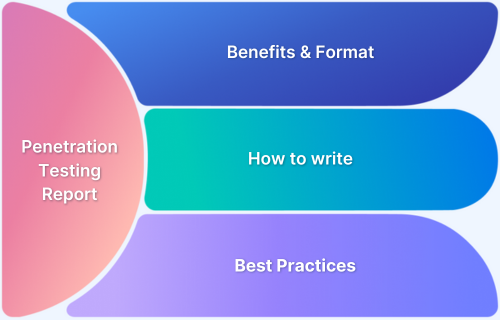Black-box penetration testing helps organizations detect external security weaknesses by uncovering gaps like misconfigurations, weak access control etc.
Overview
What is Black Box Penetration Testing?
Black-Box Penetration Testing is a cyber-security practice intended to simulate real-world attacks on networks, software, or systems. The testing team assesses the functionality of the application without being aware of its internal code, structure, or implementation.
Common Black-Box Techniques
- Fuzzing
- Vulnerability Scanning
- Web Application Scanning
- Full Port Scanning
- Open Intelligence Information Gathering
- DNS Enumeration
- Test scaffolding
- Syntax Testing
- Brute Force Attacks
- Exploratory Testing
- Password Attacks
- Monitoring program behavior
- Wireless Network Scanning
Benefits of Black Box Penetration Testing
- Realistic Testing
- Impartial Assessment
- Effective for External Threats
- Early Detection of Interface Issues
- Encourages Vigilance
- User-Centric Test
- Test Case Design Flexibility
In this article, learn in detail about black box penetration testing, common black box techniques, steps to perform it, and more.
What is a Penetration Test?
A penetration test, often called a pen test, is a cybersecurity assessment technique conducted to assess the security of a network, computer system, or application. The prime goal is to detect vulnerabilities, glitches, weaknesses, and potential entry points that malicious attackers could exploit. Pen tests simulate real-world attacks to evaluate an organization’s readiness to defend against cyber thefts.
Core Objectives of Pen Testing
The key objectives of a penetration test go beyond simply detecting vulnerabilities. They cover:
- Vulnerability Discovery: Recognizing unknown and known susceptibilities in systems and apps.
- Risk Assessment: Determining the possible influence and probability of a successful attack on detected vulnerabilities.
- Security Validation: Estimating the efficiency of current cyber-security measures and controls.
- Incident Response Test: Evaluating the company’s readiness to notice and respond to security incidents.
What is Black Box Penetration Testing?
Black-Box Penetration Testing, often referred to as Black-Box Testing, is a cyber-security practice intended to simulate real-world attacks on networks, software, or systems.
- In this technique, the testers, often called security experts or ethical hackers, have no insights into the code, architecture, or system design.
- They enter the scenario as unauthorized, external users, just like an outsider attempting to breach security.
- The black box pen test is a closed-box or external penetration test.
Key characteristics of black box testing comprise the following:
- Independent Test: Black box testing is usually conducted by testers who operate independently of the development team. This guarantees an unbiased perspective and detects glitches developers might miss.
- Requirements-Driven Test: Testers design test cases based on the software’s specifications without delving into the intricacies of how the code is executed.
- Functional Evaluation: It aims to confirm whether the software aligns with projected behavior and yields the desired outcomes for multiple inputs.
- Absence of Internal Code Knowledge: QA’s cannot access the software’s source code, design specifics, or architectural details. Their interactions with the system are solely through its UIs or APIs.
Cost of a Black Box Penetration Test
Black box penetration tests are more affordable than white-box or grey-box penetration tests, since the latter require in-depth testing. Full-scale black box pen tests usually cost in the range of $5000 – $50,000 per test.
Use Cases of Black Box Penetration Test
Here are the various use cases of Black Box Penetration testing:
- To test public-facing applications: Public-facing applications, for example, E-commerce websites, online banking portals, SaaS platforms, etc., will require black box penetration testing, since they are main targets for attackers. Black box pentests detect vulnerabilities in authentication, session management, and input validation.
- Validate Security Posture of New Releases: Before an application goes live after deploying a new feature or version, black box pen tests can be done to verify no new exposures have been introduced.
- Regulatory Compliance Checks: Black box penetration tests help achieve compliance requirements like PCI-DSS, HIPAA, or GDPR, which are compulsory for regular security assessments. This is especially needed in industries like finance, healthcare, and retail.
- Third-party Risk Evaluation: Black box penetration testing verifies there are no security threats when integrating with third-party vendors or services like third-party payment system or analytics service.
Common Black-Box Techniques
Several common black box methods during a pen test engagement could be the following:
- Fuzzing: Malformed or random inputs are sent to applications to check for crashes or any other unexpected behavior.
- Vulnerability Scanning: Systems are scanned using automated tools to detect known vulnerabilities like outdated software, misconfigurations ,etc.
- Web Application Scanning: Scans web apps to find common security errors like XSS, SQL injection, and insecure cookies via simulated attacks.
- Full Port Scanning: Finds open, closed, or filtered ports on a target system. This helps detect potential entry points.
- Open Intelligence Information Gathering (OSINT): Gathers publicly available data (like social media etc.) to find sensitive information that could drive a potential attack.
- DNS Enumeration: Uncovers domain names, subdomains, and DNS records to map target infrastructure and find weak spots.
- Test Scaffolding: Builds a temporary environment to explore and analyze the app structure.
- Syntax Testing: Introduces unexpected or malformed input like special characters or broken syntax to check how the system handles it.
- Brute Force Attacks: Username/password combinations are entered multiple times to obtain unauthorized access to apps.
- Exploratory Testing: Testers actively explore the software to identify issues and assess user experience without relying on predefined test cases.
- Password Attacks: Attempts to break into accounts using weak or reused passwords.
- Monitoring Program Behavior: Sees how the app behaves when certain inputs are provided or during execution to find abnormal activities.
- Wireless Network Scanning: This scans nearby Wi-Fi networks for unsecured access points, rogue devices, or other vulnerabilities in wireless protocols.
When do you need a Black Box Penetration Testing?
- Early Vulnerability Detection: Black Box Penetration Testing is a prime choice for companies aiming to determine vulnerabilities early in the SDLC. This proactive approach lets them address problems before they evolve into serious security threats.
- Compliance & Regulatory Obligations: Businesses operating within regulated sectors like finance, government, or healthcare often have frequent security assessments to meet compliance standards. Black Box Testing serves as a smart move to fulfill these regulatory requirements.
- Routine Security Assessments: Irrespective of industry regulations, regular security assessments, which include the Black Box Test, are vital to confirm that your safety posture remains robust and adaptable in the face of growing cyber threats.
- Third-Party System Evaluation: When integrating third-party systems or apps into your infrastructure, it is crucial to estimate their security. Black Box Test aids in evaluating potential threats linked with these integrations.
- Real-World Simulation: Black Box Testing proves valuable when replicating practical use cases and real-life scenarios. It provides insights into how well your system can withstand threats from attackers operating in real-world environments.
How to Perform Black-Box Penetration Tests (Test Methodology)
To conduct an effective Black-Box Penetration Test, a well-structured methodology is essential. While the exact steps may vary depending on the specific project and organization, here’s a general outline:
- Planning and Scoping: Define the scope of the test, including the target systems, objectives, and constraints. This step also involves obtaining necessary permissions and ensuring legal and ethical compliance.
- Reconnaissance: Collect publicly available information about the target, such as domain names, IP addresses, employee names, exposed pain points, etc. This phase helps identify potential entry points. OSINT techniques are used in this step.
- Scanning and Enumeration: Employ various tools to identify active hosts, open ports, and services running on the target systems. This information is crucial to detect potential vulnerabilities.
- Vulnerability Analysis: Utilize automated vulnerability scanning tools to detect known vulnerabilities in the target systems. This step can reveal weaknesses like outdated software versions or misconfigured settings.
- Exploitation: Attempt to exploit the identified vulnerabilities to gain unauthorized access to the target systems. Ethical hackers emulate real attackers to assess the security posture.
- Post-Exploitation and Privilege Escalation: If successful, testers escalate the extent of access to gain complete access to the system and database and evaluate the potential for further compromise. This phase helps organizations understand the severity of the breach
- Reporting: Compile comprehensive reports detailing the vulnerabilities discovered, the paths taken for exploitation, and recommendations for remediation. Clear and actionable reports are crucial for organizations to address identified weaknesses.
Read More: Guide to Android Penetration Testing
White Box vs. Grey Box vs. Black Box Penetration Testing
White box, grey box, and black box penetration testing are three different types of penetration testing. Here are the core differences between them:
| Parameter | Black-Box Testing | White Box Testing | Grey Box Testing |
|---|---|---|---|
| Methodology | This entails assessing an application or system without advanced knowledge of its internal mechanisms or inner workings. | Involves testing a system or application with a full understanding of its internal workings. | Blends both practices, wherein some awareness of the system is provided to the tester but not full knowledge or access. |
| Coverage | It can proffer a more extensive coverage perspective, assessing the app or system as an external attacker without any presumptions or internal knowledge. | It can be highly precise and focused, as the tester possesses prior knowledge of the system’s internal workings, letting a focused assessment of precise weak points or areas of vulnerability. | It lies in the middle, providing partial insight into the system’s internal workings while retaining an external perspective. |
| Speed | Is often quicker than a white box test, as the tester isn’t required to scrutinize the system’s internal operations. However, this can also lead to missed vulnerabilities that can be detected through a comprehensive analysis. | Slower, because the tester must invest time to comprehend the system’s internal operations. However, it can also lead to comprehensive testing and detection of vulnerabilities. | It serves as a balanced compromise between speed and comprehensiveness. |
| Cost | The black box test is typically more cost-effective than the white box test as it requires less time and expertise. | It can be more expensive than a black box test, requiring extra time and expertise to know and test the system comprehensively. | It strikes a balance in terms of cost, as it demands a certain level of expertise and knowledge but not to a similar extent as the white box test. |
| Objectivity | Offer a more objective perspective as the tester approaches the system without preconceived notions or biases. | Could be influenced by the tester’s prior awareness of the system. | May be influenced by prior knowledge, but to a lesser extent in contrast to white box testing. |
| Knowledge Level | No Knowledge | Full Knowledge | Partial Knowledge |
Black Box Penetration Testing: Advantages and Disadvantages
Here are the main advantages and disadvantages of conducting a black box penetration test:
| Advantages | Disadvantages |
|---|---|
| Realistic Testing: Simulate real-world risks, threats, and scenarios. | Limited Insight: Testers or QAs need to gain insider knowledge. |
| Impartial Assessment: As testers lack prior knowledge, the evaluation remains impartial, free from insider bias. | Time-Consuming: Collecting information and gaining insights from an outsider’s perspective can be time-consuming, extending the test timeline. |
| Effective for External Threats: Suitable for estimating the security of externally facing systems. | Limited Security Testing: While the black-box test can detect certain security vulnerabilities, it might not comprehensively address all potential security issues. |
| Early Detection of Interface Issues: A Black box test can uncover interface-related flaws, such as output discrepancies and input validation errors. | Inability to Evaluate Performance and Scalability: Performance-centric glitches and scalability issues might not be efficiently identified. |
| Encourages Vigilance: Encourages companies to improve their external defenses. | Not suitable for All Scenarios: Not suitable for evaluating internal threats or certain apps. |
| User-Centric Test: The Black box test concentrates on the software’s external behavior, confirming that it meets user expectations. | Inability to Test Intricate Algorithms: It may not be effective at validating intricate algorithms or complex business logic that requires understanding the internal code. |
| Suitable for Big Projects: It can be applied at distinct test levels, from acceptance tests to unit tests making it scalable for big projects. | Dependency on Requirements: Test cases are greatly dependent on the completeness & accuracy of the provided requirements. Ambiguous or incomplete requirements can result in an incomplete test |
| Test Case Design Flexibility: Several test case design methods, like boundary value analysis, and equivalence partitioning allow for smart test coverage. | Difficulty in Error Localization: Detecting the root cause of flaws noticed in black box tests could be challenging, as testers lack access to internal code. |
Black-Box Pentesting Checklist
Here’s a quick and easy checklist that contains some best practices to include during black box pen tests:
- Analyze Network
- Map web application endpoints and directories
- Utilize both automated and manual testing
- Analyze input field thoroughly
- Test for common vulnerabilities like SQL Injection, Cross-Site Scripting (XSS) etc.
- Conduct Fuzz Testing
- Credential Testing to access various credentials
- Communication Interception to spot security flaws
- Evaluate resistance to the Evasion technique
Read More: What is Mobile App Security Testing?
Conclusion
Remember, cybersecurity is not a one-time effort but an ongoing commitment. Embracing practices like Black-Box Penetration Testing can help organizations fortify their digital defenses and protect the assets that drive their success in the digital age. It provides a realistic, unbiased assessment of your external affairs and helps you stay one step ahead of potential attackers.
In this process, tools like BrowserStack are essential. By running automated tests on real devices and browsers across multiple platforms, BrowserStack ensures comprehensive testing for potential security vulnerabilities in various environments.
Frequently Asked Questions
1. Is Penetration testing black box or white box?
Penetration testing can be both white box and black box, depending on the particular goals and necessities of the assessment. Companies pick out suitable models based on their requirements. Black box testing is often used to simulate external attacks, while white box testing is employed for in-depth internal assessments.
2. What are the three 3 types of penetration Tests?
The three major types of penetration tests are:
- Black Box Penetration Testing: This testing simulates external attacks without knowledge of internal workings.
- White Box Penetration Testing: White Box testing assesses the internal security mechanisms, typically with a full understanding of the system’s internals.
- Grey Box Penetration Testing: It strikes a balance by encompassing elements from both white and black box testing methodologies. It entails having partial knowledge of the system and offering a middle-ground assessment.







